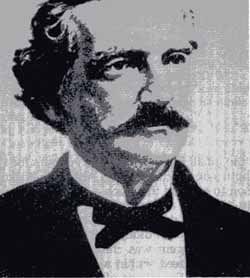Gardner Quincy Colton was the first person to administer nitrous oxide as a general anaesthetic in surgical medicine. The operation consisted in the extraction of a molar tooth from Connecticut dentist Horace Wells. Wells suggested the procedure after witnessing the antics of a young acquaintance at one of Colton's riotous entertainments. This volunteer in question, drugstore clerk Sam Cooley, badly gashed his leg while charging around under the influence of a modest dose of laughing gas. But the injured youth noticed no pain. Wells questioned Cooley closely - and fatefully wondered if higher doses of the gas might induce a condition of insensibility suitable for dental surgery. He resolved to find out.
Wells' offending molar was extracted the next day in his office by his partner, dentist John Riggs (1810-1885). Gardner Coulton presided as anaesthetist. Dr Riggs was later to lend his name to Riggs' disease, an advanced form of periodontal disease also known as pyorrhea.
"Professor" Colton was a flamboyant showman and lecturer on natural philosophy, chemistry and the telegraph. He enjoyed the rudiments of a formal medical education, but never graduated. Colton quit medical school in New York after discovering that staging public entertainments was more lucrative than medical training, and much more fun. He earned $535 from his first public demonstration of the properties of nitrous oxide. Colton was so enthusiastic about the new gas he even thought nitrous oxide might replace ethyl alcohol as the world's leading social intoxicant.
Colton headed to California during the gold rush. He didn't strike it rich, though his brother Walter was Civil Governor of state. Unsuccessful in finding gold, Colton returned East in 1863. He set up a company with two dentists, adapting the techniques of anaesthesia he had practised earlier in his career. The company was successful. It expanded into many US cities. No patient fatalities were recorded: used prudently, nitrous oxide is a fairly safe gas, especially if admixed with oxygen.
As Wells so cruelly discovered in Massachusetts, nitrous oxide is less suitable for major surgery than for dentisty, at least if it's used as the sole agent. This is because it is only a weak anaesthetic, albeit a relatively good analgesic. But Colton vigorously proselytised for its use in dental surgery. In the 1860s, Colton successfully established The Colton Dental Association in New York. He attended the first International Congress of Medicine in Paris. After 1868, Chicago surgeon Edmund Andrews (1824-1904) began combining nitrous oxide with 20% oxygen. This prevented asphyxia and permitted prolonged anaesthesia. The popularity and reputation of nitrous oxide recovered in hospital surgery as well as dentistry.
Colton's advice on how to use nitrous oxide was simple: "Instruct the patient to take full, deep and slow inspirations of the gas and hold the lips and nose so as to allow no particle of common air to enter and dilute the gas. By this means, anaesthesia will be reached in from forty-five to sixty seconds." Between 1864 and 1897, Colton and his colleagues successfully extracted teeth under nitrous oxide anaesthesia from tens of thousands of dental patients.
next
HOME
Search
Resources
Snapshots
Utopian Surgery
Refs and Further Reading
Anaesthesia and Anaesthetics
